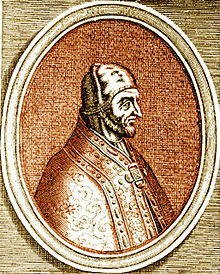Innocent VI
Innocent VI is frankly a bit of a dull pope. He possessed none of the vices of his predecessors and and was known for his integrity.
There is uncertainty about the year of his birth; it was either 1282 or 1295 and he became the fifth Avignon pope in 1352. His birth name was Étienne Aubert.
In the conclave that elected him all the cardinals agreed that whoever became pope would make it clear that the pope was subservient to the college of cardinals by dividing his power and wealth with them. Aubert made a conditional vow and when he was elected he declared the pact illegal because it would have been a limitation of the divinely conferred papal power.
He had no time for extravagance and luxury and told the cardinals that they, too, must live more simply. Intending to return the papacy to Rome, he sent representatives there, but they and their mission were rejected. He also wanted to reunite the eastern and western Christians by joining Rome and Byzantium, but that was also doomed to failure.
Unlike his predecessors he managed to maintain good relations with the Holy Roman Emperor, Charles IV. Charles was crowned in Rome by a cardinal, staying only a few hours in recognition that he was not laying any claim to territories in Italy that he had given up.
Innocent helped to negotiate the Peace of Brétigny in 1360. As a result of this the Hundred Years’ War had a brief respite. Peace, however, brought unexpected problems for the pope. Knights were trained to fight and there were suddenly hundreds of knights in France with nothing to do and no way of making a living. They knew little other than how to fight. Forming small bands, they began to roam the countryside demanding protection money from towns and villages. They were called ‘free companies’, as they were available for hire and some were made up of men from all sides of the war. One such group besieged Avignon in 1360. Despite being excommunicated by the pope, they were still there when the Black Death returned in 1361.
When people think about the Black Death they usually think of it as a one-off occurrence around the middle of the fourteenth century, but it wasn’t. It certainly swept across Europe in 1347 and 1348, but, after 1351 it disappeared again, only to return in 1361. It was less virulent and less deadly, but still fairly devastating. This time it disappeared in 1363 and returned again in 1374. Various forms of plague then returned to Europe at different intervals until the middle of the eighteenth century.
As it had in the first outbreak of the Black Death, Avignon suffered greatly, with thousands of deaths, including nine cardinals. In the end, Innocent bought off the besiegers.
Innocent carried out some much-needed reforms. Clement VI’s extravagance meant that Innocent needed to make economies. He cut back on palace staff and sold some works of art. When he died in 1362 many of the cardinals wanted to make the brother of Clement VI pope, but he declined.




Pingback: Soldiers for Hire | A Writer's Perspective
Pingback: Joan, Princess of Wales | A Writer's Perspective